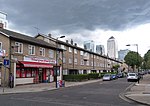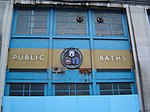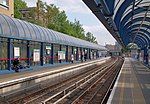Langdon Park DLR station
Docklands Light Railway stations in the London Borough of Tower HamletsPoplar, LondonRail transport stations in London fare zone 2Railway stations in Great Britain opened in 2007Use British English from August 2012

Langdon Park is a Docklands Light Railway (DLR) station in Poplar in Greater London, England. The station is between All Saints and Devons Road stations on the Stratford-Lewisham Line. Construction of the infill station began on 17 November 2006, and the first day of operation was 9 December 2007.
Excerpt from the Wikipedia article Langdon Park DLR station (License: CC BY-SA 3.0, Authors, Images).Langdon Park DLR station
Zetland Street, London Poplar
Geographical coordinates (GPS) Address Nearby Places Show on map
Geographical coordinates (GPS)
| Latitude | Longitude |
|---|---|
| N 51.515173 ° | E -0.014119 ° |
Address
Zetland Street 3
E14 6PR London, Poplar
England, United Kingdom
Open on Google Maps








